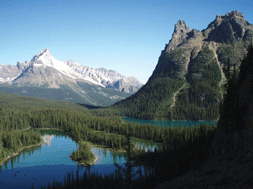Ultraviolet (UV) radiation is a globally important abiotic factor influencing ecosystem structure and function in multiple ways. While UV radiation can be damaging to most organisms, several factors act to reduce UV exposure of organisms in aquatic ecosystems, the most important of which is dissolved organic carbon (DOC). In alpine lakes, very low concentrations of DOC and a thinner atmosphere lead to unusually high UV exposure levels. These high UV levels combine with low temperatures to provide a fundamentally different vertical structure to alpine lake ecosystems in comparison to most lowland lakes. Here, we discuss the importance of water temperature and UV transparency in structuring alpine lake ecosystems and the consequences for aquatic organisms that inhabit them. We present transparency data on a global data set of alpine lakes and nearby analogous subalpine lakes for comparison. We also present seasonal transparency data on a suite of alpine and subalpine lakes that demonstrate important differences in UV and photosynthetically active radiation (PAR, 400–700 nm) transparency patterns even within a single region. These data are used to explore factors regulating transparency in alpine lakes, to discuss implications of future environmental change on the structure and function of alpine lakes, and ways in which the UV transparency of these lakes can be used as a sentinel of environmental change.

You have access to this article
 Please wait while we load your content...
Something went wrong. Try again?
Please wait while we load your content...
Something went wrong. Try again?


 Please wait while we load your content...
Please wait while we load your content...